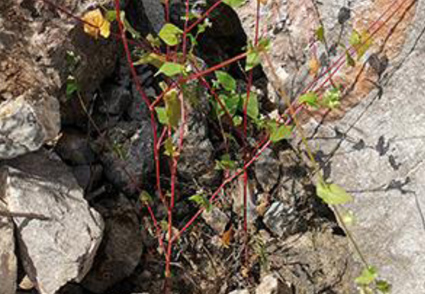Abstract
A cryptic species of Fagopyrum (Polygonaceae), F. homotropicum, is described and illustrated from Mangkang county, Tibet, China. F. homotropicum was firstly discovered in the 90’s, being to be diploid and characterized being a self-pollinating taxon. Detailed information of F. homotropiucm was rarely reported. In this paper, we summarized the morphological and karyological characters of tetraploid form F. homotropiucm (2n=4x=32), it is self-pollinating, and morphology indistinguishable in comparison from the diploid form.
References
Campbell, C. (1995) Inter-specific hybridization in the genus Fagopyrum. In: Matano, T. & Ujihara, A. (Eds.) Current Advances in Buckwheat Research. Proc. 6th Intl. Symp. Buckwheat at Ina 1. Shishu University Press, Asahi Matsumoto, pp. 255–263.
Kim, Y.B., Kim, S.L., Lee, K.C., Chang, K.J., Kim, N.S., Shin, Y.B. & Park, C.H. (2002) Interspecific hybridization between Korean buckwheat landraces (Fagopyrum esculentum Moench) and self-fertilizing buckwheat species (F. homotropicum ohnishi). Fagopyrum 19: 37–42.
Linnaeus, C. (1753) Species plantarum, vol. 1. Laurentius Salvius, Stockholm, 560 pp.
Ohnishi, O. & Matsuoka, Y. (1996) Search for the wild ancestor of buckwheat II. Taxonomy of Fagopyrum (Polygonaceae) species based on morphology, isozymes and cpDNA variability. Genes & Genetic Systems 71 (6): 383–390. https://doi.org/10.1266/ggs.71.383
Ohnishi, O. (1998) Search for the wild ancestor of buckwheat. Description of new Fagopyrum (Polygonaceae) species and their distribution in China and the Himalayan hills. Fagopyrum 15: 18–28.
Ohnishi, O. & Asano, N. (1999) Genetic diversity of Fagopyrum homotropicum, a wild species related to common buckwheat. Genetic Resources and Crop Evolution 46 (4): 389–398. https://doi.org/10.1023/A:1008640522979
Ohsako, T. & Ohnishi, O. (2000) Intra-and interspecific phylogeny of wild Fagopyrum (Polygonaceae) species based on nucleotide sequences of noncoding regions in chloroplast DNA. American Journal of Botany 87 (4): 573–582. https://doi.org/10.2307/2656601
Ohsawa, R. (2020) Current status and prospects of common buckwheat breeding in Japan. Breeding science 70 (1): 3–12. https://doi.org/10.1270/jsbbs.19108
Thiers, B. (2021) Index Herbariorum: A global directory of public herbaria and associated staff. New York Botanical Garden’s Virtual Herbarium. Available from: http://sycamore.nybg.org/science/ih (accessed 30 November 2021)
Treviranus, L.C. (1826) Horti botanici Vratislaviensis plantarum vel novarum vel minus cognitarum manipulus: descripsit et observationibus nec non tabulis tribus illustravit. Nova Acta Physico-medica Academiae Caesareae Leopoldino-Carolinae Naturae Curiosorum Exhibentia Ephemerides sive Observationes Historias et Experimenta 13 (5): 165–208.
Varoquaux, F., Blanvillain, R., Delseny, M. & Gallois, P. (2000) Less is better: new approaches for seedless fruit production. Trends in biotechnology 18 (6): 233242. https://doi.org/10.1016/S0167-7799(00)01448-7
Zhang, K., Fan, Y., Weng, W., Tang, Y. & Zhou, M. (2021) Fagopyrum longistylum (Polygonaceae), a new species from Sichuan, China. Phytotaxa 482 (2): 173–182. https://doi.org/10.11646/phytotaxa.482.2.5
Zhou, M., Tang, Y., Deng, X., Ruan, C., Tang, Y. & Wu, Y. (2018) Classification and Nomenclature of Buckwheat Plants. Buckwheat Germplasm in the World: 9–20. https://doi.org/10.1016/B978-0-12-811006-5.00002-1
Kim, Y.B., Kim, S.L., Lee, K.C., Chang, K.J., Kim, N.S., Shin, Y.B. & Park, C.H. (2002) Interspecific hybridization between Korean buckwheat landraces (Fagopyrum esculentum Moench) and self-fertilizing buckwheat species (F. homotropicum ohnishi). Fagopyrum 19: 37–42.
Linnaeus, C. (1753) Species plantarum, vol. 1. Laurentius Salvius, Stockholm, 560 pp.
Ohnishi, O. & Matsuoka, Y. (1996) Search for the wild ancestor of buckwheat II. Taxonomy of Fagopyrum (Polygonaceae) species based on morphology, isozymes and cpDNA variability. Genes & Genetic Systems 71 (6): 383–390. https://doi.org/10.1266/ggs.71.383
Ohnishi, O. (1998) Search for the wild ancestor of buckwheat. Description of new Fagopyrum (Polygonaceae) species and their distribution in China and the Himalayan hills. Fagopyrum 15: 18–28.
Ohnishi, O. & Asano, N. (1999) Genetic diversity of Fagopyrum homotropicum, a wild species related to common buckwheat. Genetic Resources and Crop Evolution 46 (4): 389–398. https://doi.org/10.1023/A:1008640522979
Ohsako, T. & Ohnishi, O. (2000) Intra-and interspecific phylogeny of wild Fagopyrum (Polygonaceae) species based on nucleotide sequences of noncoding regions in chloroplast DNA. American Journal of Botany 87 (4): 573–582. https://doi.org/10.2307/2656601
Ohsawa, R. (2020) Current status and prospects of common buckwheat breeding in Japan. Breeding science 70 (1): 3–12. https://doi.org/10.1270/jsbbs.19108
Thiers, B. (2021) Index Herbariorum: A global directory of public herbaria and associated staff. New York Botanical Garden’s Virtual Herbarium. Available from: http://sycamore.nybg.org/science/ih (accessed 30 November 2021)
Treviranus, L.C. (1826) Horti botanici Vratislaviensis plantarum vel novarum vel minus cognitarum manipulus: descripsit et observationibus nec non tabulis tribus illustravit. Nova Acta Physico-medica Academiae Caesareae Leopoldino-Carolinae Naturae Curiosorum Exhibentia Ephemerides sive Observationes Historias et Experimenta 13 (5): 165–208.
Varoquaux, F., Blanvillain, R., Delseny, M. & Gallois, P. (2000) Less is better: new approaches for seedless fruit production. Trends in biotechnology 18 (6): 233242. https://doi.org/10.1016/S0167-7799(00)01448-7
Zhang, K., Fan, Y., Weng, W., Tang, Y. & Zhou, M. (2021) Fagopyrum longistylum (Polygonaceae), a new species from Sichuan, China. Phytotaxa 482 (2): 173–182. https://doi.org/10.11646/phytotaxa.482.2.5
Zhou, M., Tang, Y., Deng, X., Ruan, C., Tang, Y. & Wu, Y. (2018) Classification and Nomenclature of Buckwheat Plants. Buckwheat Germplasm in the World: 9–20. https://doi.org/10.1016/B978-0-12-811006-5.00002-1


